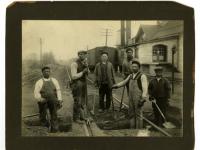Periods of mass immigration generally trigger resistance on the part of the native-born population or “older,” more established immigrant groups. With the arrival of the famine generation in the mid-19th century, the Irish encountered fierce opposition and a nativist backlash. By the late 19th and early 20th centuries, the arrival of large numbers of eastern and southeastern European immigrants spurred discussions as to how to incorporate these immigrants into American society.
The collection of resources assembled in this unit is designed to have students explore the role of these vital yet marginalized workers. From the Irish track workers of the mid-19th century who filled the ever-growing demands of the burgeoning railroad industry to the new wave of Italian immigrants in the late 19th and early 20th centuries, these laborers filled some of the least desirable and most dangerous jobs constructing and maintaining railroad lines. Use the resources in this unit to discuss attitudes towards and perceptions of Irish and Italian laborers



